Track
General
You can reach the draw tracks mode in the layout view...
by [2] or
by "Draw Tracks" in menu "Elements" or
by the tool ![]()
Leave this mode...
with [ESC] or M12
The word "track" in TARGET 3001! is used for a signal track in the layout mode (PCB). A track is the result of the process of routing which means the placement of an electrical connection between soldering pads (footprints). Signal tracks are placed upon the copper layer(s) of a PCB so at the end they come out in copper. Singlesided PCBs have only one copper layer, in most cases "copper bottom". Doublesided PCBs have two copper layers, "copper bottom" and "copper top".
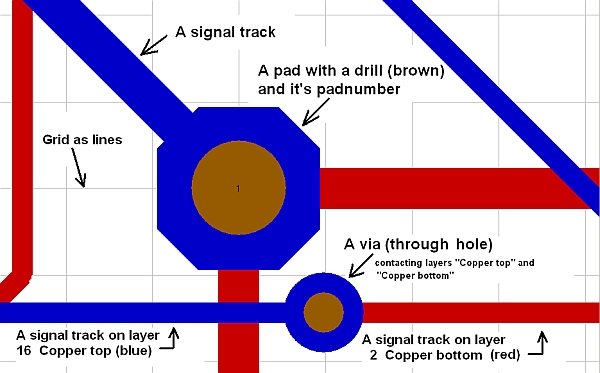
Any element visible might be doubleclicked for editing (M11).
What you can do...
The connections in your PCBs are generated by signal tracks and they behave similarly to signal wires in the schematic part. If you start a track at the end of a ratsnest wire or a defined pad, the corresponding signal name is continued (e.g. GND). If you start from a free pad, the signal name is derived from the pin name (e.g. A1). If you hit nothing special when starting the signal, a complete artificial signal name is used (e.g. Sig$17). The signal name is shown in the status line.
Adjust the bending mode while drawing tracks with M2. The [Spacebar] toggles between opposite bending modes, e.g. between both of the 45° bends. An existing track can be edited by displacing of segments [d] or by dragging its corners [g]. If you touch another signal with your new signal wire, TARGET reacts in two ways:
- PCB with schematic: TARGET tells you, that new connections can only be made in the schematic and rejects the attempt placing a new track.
- PCB without schematic: TARGET asks, whether you want to concatenate both signals. If you hit the middle of a signal wire, the wire is automatically split into two segments.
In "Draw Tracks" mode, you can manually place a via, by pressing [.] (full stop). Signal layers are exchanged, see status line. You can exchange track layers without generating a via by pressing [:]. Besides: You bring an already imported component to the opposite layer by mirroring it. Highlight it and press key [m].
The working layer can also be selected by the layer toolbar
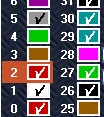
You can insert bridges by pressing the [b] key. The actual segment then still is placeded as a track, the next segment gets a bridge. The length of the bridge is defined by clicking M1 at the desired distance.
Snap-on-Pad: If you come close to a pad, TARGET 3001! shows a little Snap-on-Pad box, which attracts the cursor like a magnet. You can avoid this magnetism by pressing [Ctrl] (in reality it is a snap on grid!!) TARGET 3001! generates a beep, if you hit another track or pad. This assures you that the connection really is made.
Please note that the snap on boxes regarding their dimensions depend on the [[Grid|settings of the grid.] Having set a very small grid, the snap on box gets very small too. So it will be difficult to hit the snap on box, being crucial for a working connection. Having a grid of 0,01mm this already might lead to the mentioned difficulties. Even if you zoom in very far into your layout, the snap on box will be rather small.
Backspace Function: To delete the last drawn segments of a signal, you can use the [BACKSPACE] key. This works like "undo" and the start position of the cursor gets adapted too.
Track options
Press key [o] for applying options for coming actions. The following dialog opens:
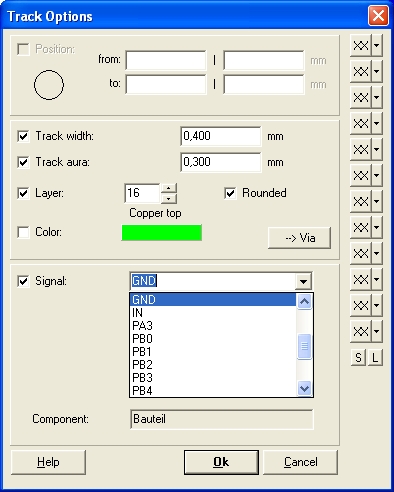
Track width: Please enter the width of the tracks you want to place.
Track aura: The tracks you will place will be added into the according deletion layer. The size of the aura will be added to each of the tracks size in this layer and be used to calculate the distance to ground planes.
Rounded: The ends of a track will get round caps. This causes smart connections of segments with sharp bends.
Layer: means the location (layer) on the board, on which the tracks will be placed. Usually, copper layers are used.
-->Via: Opens the via options dialog:
Save a set of track options with the XX-buttons to the right of the dialog. Use the little arrow right beside for explanations.
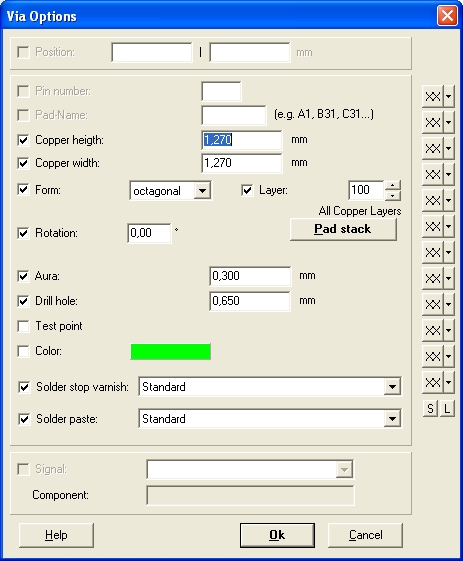
Some signal properties are very important for the auto router. They must be set in the schematic signal wires properties dialog:
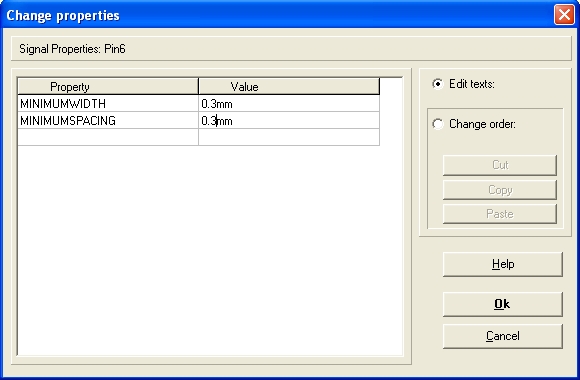
This is the setting of the track width and track spacing in respect to the autorouter's work...
Swap layers: Shift all tracks from copper top (Layer 16) to copper bottom (Layer 2) and vice versa
If you shift a track to any non track layer it loses its track properties and ends as a bare line. From this situation the track properties can not be recovered. So you need a third copper layer as a kind of a "interim parking". The editions discover, light, smart und medium have only two copper layers...
Solution: Set a free layer e.g. layer 33 to function "Position top". Now shift all copper tracks from 16 to 33. Now all tracks from 2 to 16 and all "Bridges" from 33 to 2. Lines with a signal upon position layers (like silkscreen) are taken as a bridge and keep the signal.
Deleting a track
Highlight it and use the [Del] key from your keyboard.
"But what if I can't touch it because it is covered by another element so that I can't highlight it?"
Solution: Hover the mousepointer to the spot where the desired element is placed. Now press keyboard key [s] as often until the desired element flashes. Press the return key to have it highlighted. Now delete it.
.

